Have some sympathy for Triumph's Product Manager, Simon Warburton, who was tasked in July '07 by company owner John Bloor with overseeing the development of the new version of the British manufacturer's iconic Speed Triple.
It was a big task to improve on the bike that invented the streetfighter segment back in '94. With more than 65,000 examples sold since then, the Speed Triple is the best-selling model of the Bloor era, good for almost 15 percent of the 500,000-plus bikes built since Triumph's rebirth in '90. Thus it's easy to understand the boss's concern that Warburton's design team get it right. "JB told us he wanted us to produce the next generation Speed Triple, with a new chassis and uprated engine offering more power and torque," Warburton recalls. "It had still to be recognizably a Triumph, but modernized. Although the main message to us was, in his words, 'Whatever you do, don't f**k it up!'"
The most controversial aspect of the redesign became apparent the moment the covers were whipped off the new Speed Triple at Intermot. Gone are the distinctive round headlamps with chrome bezels, replaced by twin separate pentagonal lights. "Originally we planned to keep the same lights as before," admits Warburton, "but once we had the complete prototype built up, they just didn't look right. So we went the whole way and changed them; some will like them, others won't. But it's the bike underneath that counts."
I'll say. The chance to ride the new Speed Triple came at the Ascari Race Resort in southern Spain, and as soon as you sling a leg over the bike, you realize how different it is. The all-new tubular aluminum twin-spar chassis has been completely redesigned to put more weight on the front wheel for better grip, along with sharper steering geometry for quicker handling, and a more spacious riding position that's not only more comfortable - thanks also to a thicker re-profiled seat pad - but also contributes to the improved handling. The three-cylinder 1050cc engine is located 3mm further forward in the frame, and has been canted an additional seven degrees, now slanting the cylinder block at 24 degrees. The rider has been moved a hefty 44mm closer to the front axle courtesy of a re-sculptured fuel tank, with the battery relocated to just behind the steering head, and the redesigned 2.2-pound-lighter cast aluminum single-sided swingarm is 18.5mm longer. Together with a steeper 22.8-degree rake and 90.9mm trail for greater stability (versus the previous 84mm trail measurement), these changes also result in a 10mm longer wheelbase at 56.5 inches. This helps achieve a 50.9/49.1 percent front/rear static weight bias, compared to the old bike's 48.6/51.4 rearward tilt.
All that number crunching results in a bike that immediately feels quicker and more agile-steering than the previous Speed Triple. The reach to the Magura tapered aluminum handlebar is shorter thanks also to the new riding position, which has you sitting noticeably closer to the front wheel. That's a spinoff from the considerably narrower rear subframe where the seat meets the fuel tank; the new Speed Triple frame is actually narrower than its Street Triple kid sister. This makes the bike feel slimmer when you sit on it, and combined with the slightly lower 32.5-inch seat height makes it easier for shorter riders to touch the ground at rest. The footpegs are also 16mm narrower and 29mm further forward than on the old Speed Triple.
The result is a bike with considerably improved steering and more nimble handling over its predecessor, with great turn-in on the brakes. That delivered more controlled turn-in without sacrificing agility, allowing you to take full advantage of the much-improved Brembo radial front brake package on the new Speed Triple. This was introduced three years ago on the previous model, but I never cared for it on the grounds that it was too grabby, with a fierce initial response that wasn't easy to modulate. That's now been addressed on the new bike, with a Brembo radial master cylinder replacing the previous Nissin unit in actuating the four-piston/four-pad calipers. These grip the 320mm Sunstar floating front discs with greater precision, and there's now much better feel to the lever response than before, in stopping a bike scaling 6.6 pounds less than its predecessor at a claimed 471.8 pounds fully fuelled. ABS is now available as an option on the Speed Triple for the first time, although the 5.5-pound weight penalty it entails all but cancels out the weight saved on the new bike. Regardless, there's no longer any fear of upsetting the chassis if you use the front brake mid-turn, and even with the forward weight bias and more radical steering geometry, there's no trace of instability when you brake aggressively.
I'll admit to being a little surprised when reading the spec sheet to find the new Speed Triple doesn't have a slipper clutch, as many of the more serious rivals in the class have. But my repeated efforts to provoke rear wheel chatter by grabbing downshifts (to the point of having the shifter lights flashing on the heavily revised multi-function dash) came up short - and yet there's still plenty of engine braking to help you stop. "We worked very hard to resolve this, to eliminate rear wheel chatter under braking," says the Speed Triple project's test rider, Felipe Lopez. "It took a lot of time to get right, but eventually we did it on the electronics monitoring the servo motor adjusting the idle control." This saves Triumph the extra expense as well as the weight penalty of fitting a slipper clutch.
Saving weight was a key issue for Triumph's engineers in developing the new Speed Triple, especially in terms of reduced unsprung weight as well as gyroscopic benefits to handling and acceleration. The new cast aluminum rear wheel shod with a 190/55 Metzeler Racetec KR Interact tire is an amazing 3.3 pounds lighter than on the old wheel/tire package, in spite of being upsized to a wider 6.0-inch rim instead of the 5.5-inch previously used, which in turn wore a narrower 180-size rear tire. Same thing up front, where the whole front wheel assembly is 3.1 pounds lighter, partly thanks to the 0.5mm-thinner brake discs employed, as well as the lighter wheel and Metzeler rubber. The benefits are definitely noticeable in terms of quicker, lighter steering in tighter corners in spite of the wider rear tire, especially when you have a sequence of turns in succession.
But it's done that while at the same time delivering a bit more power and a lot more grunt than before, in spite of the engine architecture remaining essentially unchanged, with the same 1050cc liquid-cooled 12-valve DOHC three-cylinder engine. The motor is Euro 3-compliant thanks to a repositioned single catalyzer that's now tucked in tight under the motor rather than the previous pair in the oval-section underseat silencers. This moves weight further forward, but also by moving the catalyzer closer to the exhaust ports, you're able to reduce its density for improved flow and reduced weight - one reason the whole exhaust system is also 2.2 pounds lighter than before. Internally, the only real change is a focus on reducing pumping losses and thus internal friction by enlarging the crankcase cylinder cavity ventilation holes from 30mm to 38mm, while the airbox filter area is 10 percent greater for increased airflow.
This refined powerplant delivers a claimed 133 horsepower at 9400 rpm, just five horsepower more than before - but there's a huge eight percent increase in maximum torque to 81.9 ft-lb at 7750 rpm. This not only addresses the loss in midrange punch that resulted from meeting Euro 3 requirements four years ago, but the shape of the torque curve on the new Speed Triple is unbelievably flat. It pulls practically right from the 1300 rpm idle, accelerates from wide open throttle at just 2000 rpm, and runs without a glitch all the way to the 10,500 rpm rev-limiter. No one in their right minds will need to rev that high; just surf the waves of smooth, supple grunt available at almost any rpm, and shift somewhere around 9000 rpm. That'll put you right back in the fat part of the torque curve between 6000-8500 rpm, where the surge of performance will keep the Speed Triple accelerating hard, accompanied by the trademark muted howl from the three-cylinder motor. Together with all the handling improvements - which the more linear new link for the fully adjustable Showa shock offering 130mm of travel plays a key role - the result is a very satisfying bike to ride, both dynamically and musically.
For after shortshifting up through the six-speed gearbox with its noticeably improved - but still slightly harsh action - revised selector mechanism, you'll find yourself making sure to blip the throttle as you back down through the gears again, just to be sure of a full concert performance. Though vibration-free thanks to the single gear-driven counterbalancer, you're always aware of the Speed Triple's engine beneath you; it has much more personality in its sound and response to the throttle than an electric-smooth four-cylinder rival like the Kawasaki Z1000 or MV Agusta Brutale. Yet the new bike is indeed more refined than its predecessor, whose elemental rawness has been smoothed away somewhat. The new Speed Triple is a better-rounded package that's easier to go fast on through the turns.
The new Speed Triple's slightly smaller 4.6-gallon fuel tank actually gives an improved range of around 170 miles, thanks to a claimed six percent improvement in fuel economy. The low fuel warning light is still hopelessly pessimistic, and comes on when you still have at least 1.6 gallons left to use. Fortunately, the all-new instrument dash features an analog tachometer to the right of the LCD with digital speedometer with twin tripmeters, coolant temp, various trip, speed and fuel consumption functions, fuel gauge, clock, and on-board diagnostics. Across the top of the dash is the usual row of shifter lights whose sequence can be set according to rider preference - though the one thing you can't alter is the 10,500-rpm rev limiter. The system is programmed to accept Triumph's optional TPMS tire pressure-monitoring system, and Triumph's first coded-key immobilizer system is now a standard feature on the bike.
Interestingly, the new Speed Triple comes in rather conservative hues of black, white, or red. As before, a full set of dedicated accessories is also available, including the flyscreen that's surely a must-have item, as well as a rear hugger, bellypan, seat cowl, frame protectors etc. There is also a choice of two optional freer-flowing Arrow exhausts incorporating chromed heat shields and end caps; one is a slip-on, the other a full titanium system "for track use only." Triumph says more than 50 percent of their Speed Triple customers opt for an aftermarket exhaust - imagine that.
If it ain't broke, don't fix it. That's the cliché which governs all manufacturers' product development cycles, try as they may to convey the impression of constant evolution. It's an adage that Ducati famously forgot in creating the unloved 999, yet which Triumph has carefully adhered to in producing the 2011-model Speed Triple. The new, much improved Speed Triple is a bike you'll be looking for excuses to go out and ride on the kind of roads that demand to be hustled along, using its improved torque and handling to best advantage. This restyled motorcycle retains the posture and in-your-face attitude of the original bike, which very definitely wasn't broke, but has been suitably refreshed. It's still got plenty of attitude, and the performance to back it up.
** Specifications
2011 Triumph Speed Triple
MSRP: TBA
Engine**
Type: Liquid-cooled, DOHC, inline-triple
Displacement: 1050cc
Bore x stroke: 79 x 71.4mm
Compression ratio: 12.0:1
Induction: Keihin EFI, 46mm throttle bodies, single injector/cyl.
Chassis
Front tire: Metzeler Racetec KR Interact, 120/70ZR-17
Rear tire: Metzeler Racetec KR Interact, 190/55ZR-17
Rake/trail: 22.8 deg./3.6 in. (90.9mm)
Wheelbase: 56.5 in. (1435mm)
Fuel capacity: 4.6 gal. (17.5L)
Claimed wet weight: 471.8 lb. (214kg) full fuel, ready to ride











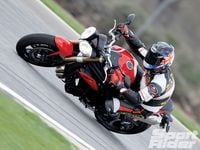
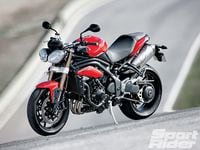

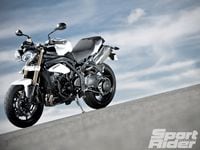
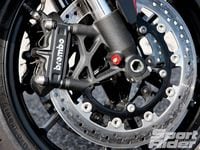
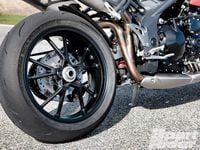
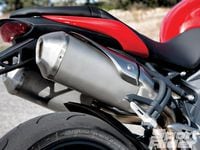
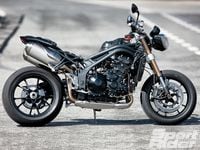
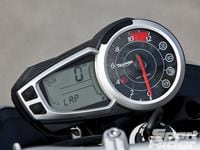
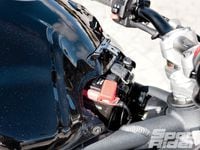
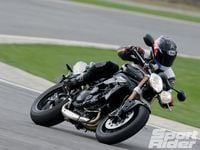
/cloudfront-us-east-1.images.arcpublishing.com/octane/EFFSPCZVBBCMTNGVEQMB7NNKIU.jpg)
/cloudfront-us-east-1.images.arcpublishing.com/octane/5GP3PUGFKVGUVCEYG4ZBDYLNBE.jpg)
/cloudfront-us-east-1.images.arcpublishing.com/octane/USTSFGXT3ZGL7BT7B66WMSSKTI.jpg)
/cloudfront-us-east-1.images.arcpublishing.com/octane/Z7YU6FSR6NEKVMKT5CZPMKIVLE.jpg)
/cloudfront-us-east-1.images.arcpublishing.com/octane/MOP35BTV3FFANFBUJKU2RJRTZ4.jpg)
/cloudfront-us-east-1.images.arcpublishing.com/octane/UWTN4NTIJFD25MPXBOVS4DFOXE.jpg)
/cloudfront-us-east-1.images.arcpublishing.com/octane/SIFOY54XMFGEHAUYNFUYVW7IZ4.jpg)
/cloudfront-us-east-1.images.arcpublishing.com/octane/HMC5X3JZHRASXGVCVNBJBWWGSI.jpg)
/cloudfront-us-east-1.images.arcpublishing.com/octane/UIWGXRZDM5HZXJOWXET2DZIWJE.jpg)
/cloudfront-us-east-1.images.arcpublishing.com/octane/QSS5DZ6SKJEU3AKE4KDAWYBEFY.jpg)
/cloudfront-us-east-1.images.arcpublishing.com/octane/SMCEQCLWRVEFTJJES6TAHB3OOQ.jpg)
/cloudfront-us-east-1.images.arcpublishing.com/octane/JCACIDCAC5FUNPTXO2BOUHGGII.jpg)
/cloudfront-us-east-1.images.arcpublishing.com/octane/DC7ZGILA2BCJXHZIUNYGV7JSEA.jpg)
/cloudfront-us-east-1.images.arcpublishing.com/octane/EWJEZUGWEZGABDEQWB64WL46GQ.jpg)
/cloudfront-us-east-1.images.arcpublishing.com/octane/5NHBMRMSFVD5JAPFNMBMNPGXQE.jpg)
/cloudfront-us-east-1.images.arcpublishing.com/octane/WHE43SCPLJBRNANAJAGXHOAIEU.jpg)
/cloudfront-us-east-1.images.arcpublishing.com/octane/6R56AQAW6NDE7BBIJ3SMCOOY5A.jpg)
/cloudfront-us-east-1.images.arcpublishing.com/octane/JMQTUE2FKZFURJTJXDMM4V47AQ.jpg)
/cloudfront-us-east-1.images.arcpublishing.com/octane/P2QYJDMQNVEANMQFXHNB3OVFKQ.jpg)
/cloudfront-us-east-1.images.arcpublishing.com/octane/VNKGXM4AA5BPRGERJOPV6GADAQ.jpg)
/cloudfront-us-east-1.images.arcpublishing.com/octane/2WS4YIFLTNG25L25WP7ZFLSWJM.jpg)
/cloudfront-us-east-1.images.arcpublishing.com/octane/UXRS6ZVQZFC23FY2EDYNT5WMVA.jpg)
/cloudfront-us-east-1.images.arcpublishing.com/octane/7JETMCKNVRGDZIGB3JCITGLPUU.jpg)
/cloudfront-us-east-1.images.arcpublishing.com/octane/OZV6E2KNIJDVHGOKXQQ2AHKLHQ.jpg)